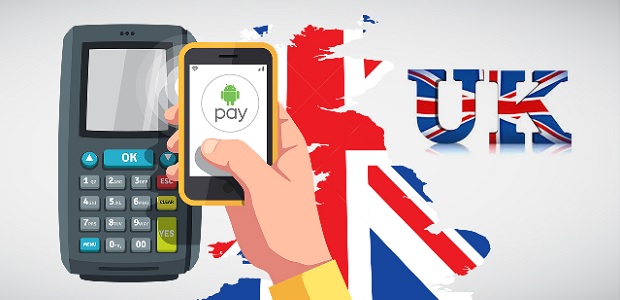
Google’s Android Pay mobile payment system has launched in the UK, enabling users to make purchases using a smartphone.
The „tap and go” system lets users of Android smartphones – including those made by HTC, Samsung, Sony and Huawei – store a digital version of their debit or credit card on their device. They pay for items by tapping it against a contactless card point, including in high street stores and on the London transport system.
Most of the major UK banks have signed up for the Android system from launch day, so holders of an eligible Visa or MasterCard at Bank of Scotland, First Direct, Halifax, HSBC, Lloyds Bank, M&S Bank, MBNA and Nationwide Building Society can now use Android Pay.
An Android Pay app has been launched to help users set up and manage their transactions. The payment system can also be used within certain apps as a form of payment.
Once they have downloaded the app and added their cards, users can make tap and pay payments at 460,000 contactless terminals across the country, including Transport for London tube, bus and train travel. The system can also be used to buy goods in third-party apps, saving users from re-keying payments details in multiple apps.
Android Pay enables users to make transactions of up to £30 without unlocking their phone, while payments of more than £30 can be completed by confirming using a fingerprint or pin entry. All transactions are encrypted for additional security, with specially generated digital tokens used instead of real card details when a purchase is made, to protect personal information.
Pali Bhat, Google’s senior director of product management, said: „Security is at the centre of Android Pay. With industry standard tokenisation, Android Pay doesn’t send merchants your real card number when you purchase. „Android Pay also makes it convenient to keep track of payments and to lock your device if it becomes lost or stolen.”
The system will work on any Android smartphone with near-field communication (NFC) technology built in and at least version 4.4 of the Android operating system. This means most Android devices released in the last two years are compatible.
Android smartphones claim a 54% market share in the UK, giving the network significant scale as it bids to take on Apple Pay, which arrived in the country last summer. To encourage takeup, an ‘Android Pay Day’ will bring special offers each month from the likes of Starbucks and Deliveroo.
Google says that more banks are also lined up to support the technology in the near future, although Barclays last week confirmed that it plans to go it alone with an inhouse contactless payments service for Android handsets.
Jimmy McLoughlin, digital economy lead at the Institute of Directors, says: „Consumers are enthusiastically adopting new methods of payment, changing the way we shop and creating opportunities for innovative companies. We are already the contactless capital of the world, and Android pay gives customers another option for quick and convenient payment.”
First launched in the USA in September, by March Android Pay was picking up 1.5 million new registrations each month. Next up, it will arrive in Singapore and Australia, with more countries to follow in the coming months.
Source: dailymail.co.uk & finextra.com
Banking 4.0 – „how was the experience for you”
„So many people are coming here to Bucharest, people that I see and interact on linkedin and now I get the change to meet them in person. It was like being to the Football World Cup but this was the World Cup on linkedin in payments and open banking.”
Many more interesting quotes in the video below: